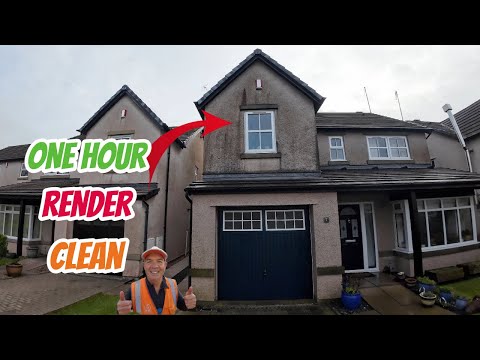
A quick video to show how we can softwash & steam clean the front elevation of a property in an hour.
How to clean rendered walls contaminated with Trentepohlia algae, mould, bacteria and organic biofilm by softwashing.
One of the main advantages of a soft wash or as it’s known softwashing is that it is applied at low pressure, which ensures that even delicate surfaces aren’t damaged. This makes it the perfect cleaning method for those who want to maintain the look of their property without causing any harm to surface.
It’s different to Pressure Washing or Jetwashing in that it utilises low pressure to apply chemicals and rinse with hot water.
Softwashing kills the living spores of algae, mould, bacteria and organic biofilm that cold water pressure washing cannot remove.
Softwashing is a cleaning method used to remove dirt, grime, algae, and other organic growth from exterior surfaces of buildings and other structures. Unlike traditional power washing or pressure washing, softwashing uses a low-pressure water stream and specialised cleaning solutions to gently clean the surface without causing damage.
Softwashing typically involves applying a cleaning solution to the surface being cleaned, allowing it to dwell for a short period of time, and then rinsing it off with a low-pressure water stream. The cleaning solution is specifically designed to break down and remove organic growth, such as algae, moss, and lichen, without harming the surface being cleaned.
Softwashing is often used on surfaces such as roofs, siding, decks, fences, and sidewalks. It is a more gentle and effective cleaning method than traditional power washing or pressure washing, and can help to extend the life of exterior surfaces by removing harmful organic growth that can cause damage over time.
Trentepohlia is a genus of filamentous algae that can grow on a variety of building exteriors. It is characterised by its reddish-orange colour, which is due to the presence of pigments called carotenoids.
Trentepohlia is commonly found in humid and shaded environments, and its growth can be influenced by factors such as temperature, moisture, and nutrient availability.
Trentepohlia is known to cause aesthetic damage to buildings by staining them with its characteristic orange colour.
Tyrolean render is a type of textured wall finish, It is a decorative, rough-coat rendering technique that provides a distinctive, rugged appearance to the exterior of a building.
The process involves applying a mixture of sand, cement, and water onto the surface of the wall using a tyrolean gun. The tyrolean gun sprays the mixture onto the wall, producing a textured finish that resembles small, raised dots. The size and shape of the dots can be adjusted by altering the size of the nozzle on the tyrolean gun.
Once the tyrolean render has been applied, it is left to dry and then typically painted with a breathable mineral-based paint. The result is a durable, weather-resistant finish that provides both visual appeal and protection for the underlying structure.
Tyrolean render is particularly popular due to its ability to withstand harsh weather conditions, as well as its ability to blend in with the surrounding landscape.
Leave a Reply